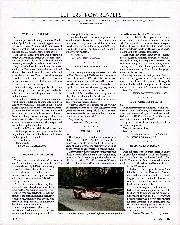
More Irwin memories
Sir, Thank you for the article about Chris Irwin in your March edition, and thank you also to Mike Gardener (Letters, April 2003) and the many people from all over…
and way back in 1938/39 they built a supercharged 4-cylinder 250 c.c. racing bike, long before the Japanese had learnt what a motorcycle was. Benelli’s latest effort is a remarkable six cylinder engine of 750 c.c. capacity, mounted transversely in a road-going motorcycle, in order to join in the Super-bike market. Like Ferrari and his 13B coupe, the price of the six-cylinder Benelli is pretty academic, but also like Ferrari there is the thought that this is a project with an ulterior motive, for in the motorcycle racing world there is a 750 c.c. Formula that is gaining impetus in spite of officialdom trying to hold it back. The very fine Woking all-alloy air-cooled six-cylinder Benelli engine is quoted as giving 76 b.h.p. at 9,000 r.p.m., which is a lot of horsepower to have in a road-going motorcycle. Apart from de Tomato being closely tied with the Benelli development and its racing involvement it is also interesting that some engineers left the Maserati firm when the Citroen engineers moved in, and they joined de Tomaso, and are now deeply involved with Benelli.
Maserati
Although Citroen own the Maserati firm and control their activities with the production of the V6 engine for the Citroen SM, the Maserati still exists as a separate and independent make. Like Aston Martin they struggled to hold on to past glories, with large ungainly frontengined GT cars, the Indy and the Ghibli being the last of the Dinosaurs. Eventually Maserati succumbed to the race-bred way of thinking and produced the Maserati “-Bora”, a mid-engined COUpé using the 4..7-litre V8 engine from the front-engined cars. Somehow one got the feeling that the Maserati management were not really convinced about the “Bora”, and though it went into production there was a lack of seriousness about it. It seemed to be the last dying gasp of an era that was gone, rather than a brave step into the future. Maserati have now come out with an entirely new mid-engined Coupe, called the “Merak”, and this makes a lot of sense. In effect it is the Citroen SM turned through 180-degrees. While the SM uses the 4-camshaft V6 Maserati engine and 5-speed Citroen gearbox to drive the front wheels, with the whole power-pack just in front of the cockpit, the “Merak” uses the same mechanical components mounted just behind the cockpit. Because Italy does not have the arbitary 2.8litre limit involved with taxation, the engine in the “Merak” has been brought up to 2,965 c.c., or a nice round 3-litres. It does not use the advanced hydropneumatic suspension, power braking and powersteering of the SM, being content with orthodox wishbone and coilspring all-round independent wheel suspension, but it does use the instrumentation and interior scuttle layout of the SM. Clearly much of the knowledge gained with the mid-engined V8 “Bora” has been passed on to the mid-engined V6 “Merak”, especially as regards the front luggage compartment and the interior layout to achieve a compromise between the ideal and the practical, but the impression is that the V8 “Bora” was the end of the pure Maserati line and the “Merak” is the beginning Of a new Citroen influenced Maserati line, and of the two the “new” looks the most encouraging.
Grand Prix International
Yet another association has been formed, this time by the Grand Prix race organisers and circuit managements, and it is called “Grand Prix International”. In spite of flowey words and political phraseology this is yet another Trade Union, formed so that its Shop Steward can attend meetings of the CSI and combat the activities of the other powerful Unions, such as the Formula One Constructors Union and the Grand Prix Drivers Union. Of course, it could happen that all these specialist groups could work together for the overall benefit of the sport, but it is unlikely, and the words boycott, strike, industrial action and bloody-mindedness will no doubt figure high on the Agenda. It is only fair that the Grand Prix organisers should
have their own man on the spot, for in the past decisions have been made by COnstructors and Drivers groups and the race organisers or the circuit management have been itresented with a foii accompli, which they did not always agree with. Eventually, there will be NO many committees, associations and unions, that meetings will occupy everyone full time and there will not he any time for actual racing, and that could solve a lot of the problems of today-I). S. J.



